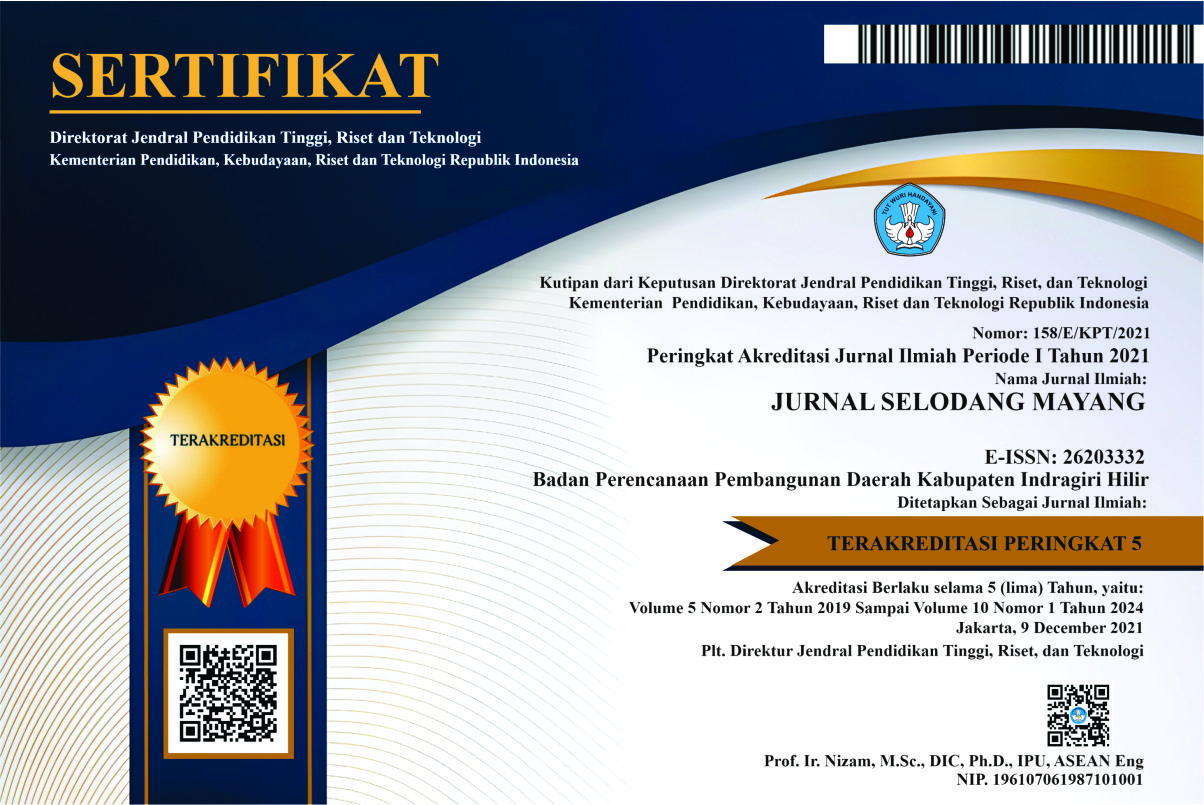PERUBAHAN SIFAT KIMIA DAN POPULASI MIKROBILOGI SELAMA FERMENTASI
Abstract
This study aims to determine changes in chemical properties in the fermentation of dried cocoa beans. Sun-dried cocoa beans obtained from farmers have a non-uniform moisture content. In order to minimize fermentation failure, dry cocoa beans are obtained by drying fresh cocoa beans using a dryer cabinet with previously conditioned temperatures such as drying with sunlight, and each sugar content is determined. Fermentation experiments of dried cocoa beans were carried out fermentation in fermentation containers with a number of beans of 150 grams per container. Before fermenting, dry cocoa beans are rehydrated so that the moisture content is close to fresh beans, then dried cocoa beans are incubated for six days without being turned over during fermentation. Each treatment was repeated three times and observed every 24 hours to 120 hours. The results showed that chemical and physical changes increased according to SNI.
Penelitian ini bertujuan untuk mengetahui perubahan sifat kimia pada fermentasi biji kakao kering jemur. Biji kakao kering jemur yang diperoleh dari petani memiliki kadar air yang tidak seragam. Guna menimalkan kegagalan fermentasi maka biji kakao kering jemur diperoleh melalui pengeringan biji kakao segar menggunakan kabinet dryer dengan sebelumnya dikondisikan pada suhu seperti pengeringan dengan sinar matahari, dan masing ditentukan kadar gula reduksinya. Percobaan fermentasi biji kakao kering dilakukan fermentasi pada wadah fermentasi dengan jumlah biji 150 gram setiap wadah. Sebelum difermentasi terlebih dahulu biji kakao kering jemur di rehidrasi agar didapat kadar air mendekati biji segar, kemudian biji kakao kering jemur diinkubasi selama enam hari dan tanpa dibalik selama fermentasi. Setiap perlakuan diulangi tiga kali dan diamati tiap 24 jam sampai 120 jam. Hasil penelitian menunjukan perubahan kimia dan fisik mengalami peningkatan sesuai SNI.
References
[2] M. Apriyanto, H. Mardesci, and Rujiah, “PERUBAHAN ASAM ASETAT, TOTAL POLIFENOL DAN WARNA BIJI KAKAO ASALAN SELAMA FERMENTASI Change of Acetic Acid, Total Polifenol and Color of Coconut Origin During Fermentation,” Jurnal Industri Hasil Perkebunan, vol. 15, no. 1, pp. 10–16, 2020.
[3] M. Apriyanto, “Latar Belakang Masalah Penelitian,” in Metodologi Penelitian Pertanian, Nuta Media, 2021.
[4] P. M. Etaware, “The effects of the phytochemistry of cocoa on the food chemistry of chocolate(s) and how disease resistance in cocoa can be improved using CRISPR/Cas9 technology,” Food Chemistry: Molecular Sciences, vol. 3, p. 100043, Dec. 2021, doi: 10.1016/j.fochms.2021.100043.
[5] M. Kahala, S. Mäkinen, and A. Pihlanto, “Impact of Fermentation on Antinutritional Factors,” in Bioactive Compounds in Fermented Foods, New York: CRC Press, 2021, pp. 185–206. doi: 10.1201/9780429027413-10.
[6] R. Chourasia, C. L. Phukon, and M. M. Abedin, “Microbial Transformation during Gut Fermentation,” in Bioactive Compounds in Fermented Foods: Health Aspects, books.google.com, 2021.
[7] W. Haliza, E. Y. Purwani, Fardiaz Dedi, and M. T. Suhartono, “KAKAO FERMENTASI : PELEPASAN PEPTIDA BIOAKTIF DAN MANFAATNYA BAGI KESEHATAN,” Perspektif, vol. 18, no. 2, 2019, doi: : http://dx.doi.org/10.21082/psp.v18n2.2019, 104 -119.
[8] M. M. Oliveira, B. V. Cerqueira, S. Barbon, and D. F. Barbin, “Classification of fermented cocoa beans (cut test) using computer vision,” Journal of Food Composition and Analysis, vol. 97, no. 1, p. 103771, Apr. 2021, doi: 10.1016/j.jfca.2020.103771.
[9] R. Gupta and M. Meghwal, “Fermented Food Based on Cereal and Pulses,” in Advances in Cereals Processing Technologies, books.google.com, 2021.
[10] A. H. Lee et al., “A laboratory-scale model cocoa fermentation using dried, unfermented beans and artificial pulp can simulate the microbial and chemical changes of on-farm cocoa fermentation,” European Food Research and Technology, vol. 245, no. 2, pp. 511–519, Feb. 2019, doi: 10.1007/s00217-018-3171-8.
[11] E. O. Afoakwa, J. Quao, J. Takrama, A. S. Budu, and F. K. Saalia, “Chemical composition and physical quality characteristics of Ghanaian cocoa beans as affected by pulp pre-conditioning and fermentation,” Journal of Food Science and Technology, vol. 50, no. 6, pp. 1097–1105, 2013, doi: 10.1007/s13197-011-0446-5.
[12] H. Mardesci, R. R. Utami, and M. Apriyanto, “IMPACT OF ADDING NKL AND FERMIPAN YEAST: MICROBIAL POPULATION AND DISCOLORATION OF COCOA BEAN ‘ASALAN’ CHIPS DURING FERMENTATION,” Jurnal Industri Hasil Perkebunan, vol. 18, no. 1, pp. 13–23, 2023.
[13] A. Rahmadi, Y. Yunus, M. Ulfah, K. P. Candra, and S. Suwasono, “Fermentasi Terinduksi Acetobacter aceti dan Saccharomyces cerevisiae untuk Industri Kakao di Kalimantan Timur,” Jurnal Riset Teknologi Industri, vol. 15, no. 2, p. 327, Dec. 2021, doi: 10.26578/jrti.v15i2.6997.
[14] M. Apriyanto and R. Novitasari, “During Fermentation, Microbiology and Biochemistry of the Cocoa Bean,” International Journal of Food Science and Agriculture, vol. 5, no. 4, pp. 688–691, Nov. 2021, doi: 10.26855/ijfsa.2021.12.016.
[15] S. Ramlah, W. Wahyuni, A. N. Amalia, and D. Indriana, “KARAKTERISTIK KIMIA, SENSORI DAN MIKROBIOLOGI COKELAT DENGAN CAMPURAN SAWI HIJAU DAN JAGUNG MANIS (Zea mays, L.) MENGGUNAKAN BIJI KAKAO FERMENTASI,” Jurnal Industri Hasil Perkebunan, vol. 17, no. 2, p. 14, Dec. 2022, doi: 10.33104/jihp.v17i2.7825.
[16] N. Luh, P. Novi, A. Aryani, N. L. Yulianti, and G. Arda, “Karakteristik Biji Kakao Hasil Fermentasi Kapasitas Kecil dengan Jenis Wadah dan Lama Fermentasi yang Berbeda,” JURNAL BETA (BIOSISTEM DAN TEKNIK PERTANIAN, vol. 6, no. 1, pp. 17–24, 2018.
[17] H. A. Sigalingging, S. H. Putri, and T. Iflah, “PERUBAHAN FISIK DAN KIMIA BIJI KAKAO SELAMA FERMENTASI,” Jurnal Industri Pertanian, vol. 2, no. 2, 2020.
[18] N. C. Misbakh, L. Cempaka, W. David, and N. Asiah, “Studi Meta-analisis: Pengaruh Penambahan Kultur Starter pada Profil Fermentasi, Mikroorganisme, dan Metabolit Hasil Fermentasi Biji Kakao (Theobroma cacao L.),” Jurnal Agro Industri Perkebunan, vol. 10, no. 2, pp. 77–96, Oct. 2022, doi: 10.25181/jaip.v10i2.2545.
[19] R. Marpaung and S. N. Putri, “KARAKTERISTIK MUTU ORGANOLEPTIK OLAHAN COKLAT DENGAN LAMA FERMENTASI YANG BERBEDA PADA BIJI KAKAO LINDAK (Theobroma cacao L.)”.,” Jurnal Media Pertanian, vol. 4, no. 2, p. 64, Nov. 2019, doi: 10.33087/jagro.v4i2.83.
[20] N. L. M. PRADNYAWATHI, I. K. A. WIJAYA, I. N. SUTEDJA, and A. A. M. ASTININGSIH, “Kajian Beberapa Cara Fermentasi yang Dilakukan oleh Petani terhadap Mutu Biji Kakao (Theobroma cacao L.),” Agrotrop : Journal on Agriculture Science, vol. 8, no. 2, p. 189, Jul. 2019, doi: 10.24843/AJoAS.2018.v08.i02.p10.
[21] M. Apriyanto and R. Rujiah, “Penurunan total polifenol, etanol, asam laktat, asam asetat, dan asam amino selama fermentasi biji kakao asalan dengan penambahan inokulum,” Jurnal Gizi dan Dietetik Indonesia (Indonesian Journal of Nutrition and Dietetics), vol. 5, no. 1, pp. 1–8, 2018, doi: 10.21927/ijnd.2017.5(1).1-8.
[22] D. Nurhayati, Y. S. Mulia, and A. F. Azhiima, “PENGARUH INHIBITOR SISTEIN PADA FERMENTASI BIJI KAKAO TERHADAP KANDUNGAN POLIFENOL,” JURNAL RISET KESEHATAN POLTEKKES DEPKES BANDUNG, vol. 14, no. 1, pp. 191–196, May 2022, doi: 10.34011/juriskesbdg.v14i1.2021.
[23] N. Alam et al., “PENGEMBANGAN TEKNIK FERMENTASI DALAM MENINGKATKAN MUTU BIJI KAKAO (Theobroma cacao L),” e.j. Agrotekbis, vol. 10, no. 6, 2022.
Copyright (c) 2024 Selodang Mayang: Jurnal Ilmiah Badan Perencanaan Pembangunan Daerah Kabupaten Indragiri Hilir

This work is licensed under a Creative Commons Attribution-ShareAlike 4.0 International License.










